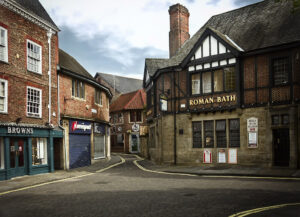Cardiff plans for Castle Street NO2 measures
A detailed assessment of Cardiff’s air quality has indicated that one road in the city is likely to exceed the legal limit for nitrogen dioxide air pollution beyond 2021.
Carried out on behalf of the council by consultancy firm Ricardo — the assessment is being used to inform the council’s plan to bring NO2 in line with legal limits, following a legal direction by the Welsh Government.

Cardiff’s Castle Street is forecast to exceed NO2 limits beyond 2021
According to the study, Castle Street, which runs in front of the Cardiff Castle from Westgate Street to Duke Street, is likely to exceed the 40μg/m3 legal limit beyond 2021 if no action is taken to reduce pollution from road transport.
The details of the local modelling differ with projected exceedances forecast by the Department for Environment, Food and Rural Affairs (Defra), which had forecast that two roads — Eastern Avenue and Bay Link by Cardiff Bay Retail Park — were likely to exceed the legal limit.
The council has until June 2019 to compile a plan as to how it will address the NO2 levels on Castle Street within the shortest possible time, using a charging Clean Air Zone as the benchmark option.
Proposals
Councillors will be asked to approve the next steps in the plan at a meeting on Thursday (15 November), which will include carrying out an assessment of the potential options for improving air quality at the location.

Buses are thought to account for around 19% of NOx emissions
Commenting on the data, Councillor Caro Wild, Cabinet Member for Strategic Planning and Transport, said: “Air pollution on Castle Street is the symptom of a wider problem which extends far beyond this stretch of road. We may be within legal limits across the city, but the cleaner we can make the air the better it will be for everyone.
“We will now look at introducing a range of measures, which will not only fix the problem on Castle Street, but which will also help make the air we breathe across the city cleaner. The council will be calling on Welsh Government for the necessary funding to bring these measures into place as soon as possible.”
According to baseline data assessed as part of the analysis emissions from road traffic accounts for 80-84% of NOx air pollution, while the remainder of the pollution is from background sources.
Overall, diesel cars are the main contributor (36%) followed by buses (19%) and Heavy Goods Vehicles (HGVs 18%), the study notes.
In 2021 the main contribution to pollution in Cardiff is still anticipated to be road traffic (73 — 78%) with diesel cars still forecasted to contribute the largest proportion of road NOx emissions (36%).
Assessment
Measures under consideration to reduce emissions currently include the potential expansion of 20 mph speed restriction zones, further development of cycling infrastructure, increasing the number of zero emission buses on the city’s network and introducing a minimum vehicle emissions standard through the city’s taxi licensing policy.

Projected NO2 exceedances for Cardiff in 2021 (Source: Cardiff city council)
Cllr Wild added: “We will now model interventions to find the quickest way to solve the problem on Castle Street and to reduce pollution levels elsewhere.
“We will need Welsh Government’s full financial backing to reduce NO2 pollution. In the meantime there are immediate things we can all do to help. I would urge people to begin by reducing their reliance on private cars, and where feasible move towards other forms of sustainable transport, such as walking, cycling or public transport. The figures speak for themselves, traffic is responsible for around 80% of NO2 measured at the roadside so we need to change the way we do things.
“If we can shift the way people move around the city – and we have plans to make public transport easier and more efficient while improving cycling and walking options – then we can all help to make the city healthier while reducing pollution and congestion on our roads.”
A deadline of June 30 2019 has been set for Welsh councils to put forward their final plans to the Welsh Government.
Waste fleet
Last week the council announced a new fleet of waste management and street cleaning vehicles that it is hoped will contribute to a reduction in emissions compared to the existing fleet.
27 new Euro VI waste collection vehicles; seven food waste collection vehicles; four hook lift vehicles; one skip loader and 12 street-cleaning vehicles will form the new fleet and a new electric, street-cleansing vehicle will also be trialled in the city centre.
Councillor Michael Michael, Cabinet Member for Clean Street, Recycling and the Environment said: “Reducing traffic emissions from our fleet is a priority. We have previously set out that we want to convert our small fleet of vehicles, away from diesel and petrol to an alternative fuel by 2022 and we want our heavy-goods vehicles converted by 2030.
“As part of this procurement we wanted to be sure we weren’t tied to these vehicles for a set period of time so we can try new vehicles with new technology which might deliver even cleaner vehicles as and when they come on stream. It’s important that we are able to adapt quickly as technology improves.”
Related Links
Report – Cardiff city council air quality study
















